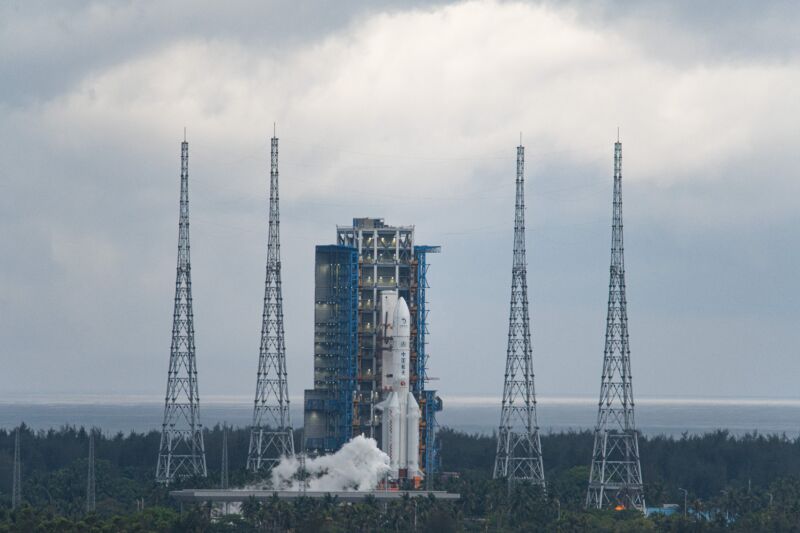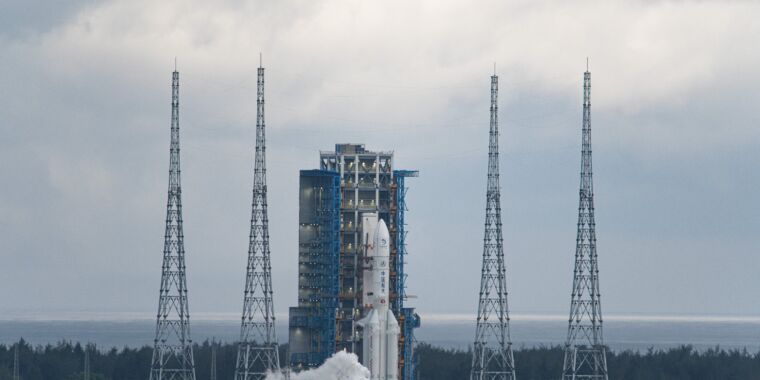
Li Zhenzhou/VCG via Getty Images
China successfully landed a spacecraft on the moon for the fourth time this weekend, successfully placing the Chang’e-6 lander in the South Pole-Aitken Basin on the far side of the moon.
After landing on Saturday evening (US time), the autonomous spacecraft will have about 48 hours to collect samples, which will be done in two different ways: by drilling to collect material from underground, and by using a robotic arm to collect regolith from the surface.
Part of the spacecraft will then lift off from the lunar surface and return to China, likely on Monday evening US time. If successful, it will be the first time that samples have been brought back to Earth from the far side of the moon.
A systematic approach
This is China’s most ambitious lunar mission to date, building on previous lunar spaceflights in stages. With the Chang’e-3 mission in December 2013, China successfully landed a small vehicle and a rover on the near side of the moon. Five years later, it launched the relay spacecraft Queqiao-1, and then landed on the far side of the moon with the Chang’e-4 mission. No country has ever landed on the far side of the moon, which has no line-of-sight communication with Earth.
Then, in December 2020, China landed on the near side of the moon with its Chang’e-5 mission. The spacecraft ultimately returned 1.7 kilograms of lunar dust and rocks to Earth, joining the United States and the Soviet Union as the only countries to have returned samples from the moon.
China’s latest mission, Chang’e-6, combined elements from its two previous lunar probes to bring back material from the little-explored far side of the moon, and future robotic missions will likely focus on exploring the lunar south pole with a view to landing humans there.
Geopolitical influences
China has set a goal of landing two astronauts on the moon, Apollo-style, by 2030, and eventually establishing a “research base” in Antarctica. As China continues to expand its lunar construction, this could happen in the late 2030s. Given the country’s straightforward approach so far, these timelines seem achievable.
As this situation continues, NASA is leading its own international lunar exploration program. NASA’s effort is more complex, incorporating government-only, privately-led, and semi-private lunar exploration missions. Its Artemis program nominally targets the first crewed landing in 2026, although no reasonable observer believes this date is realistic; a more realistic time frame is 2028-2032.
NASA’s plan is fairly complex, but it should ultimately be more sustainable because it combines government and private investments. It will also be more economical because it uses rockets and spacecraft that are partially or mostly reusable. NASA is looking to transition to reusable rockets and in-space refueling, a bet on the future of space transportation rather than looking back at the achievements of the Apollo era. However, it is not clear whether this future of reusable spaceflight is five years away, as NASA hopes, or 20 years away.
The biggest story in space over the next decade will be how this “race” plays out: which country will reach the moon first, China’s space program or NASA, and, just as important, which country has the more sustainable program. For China, simply replicating NASA’s Apollo program may be enough. For NASA, that would be a policy failure.
Big bets
While China’s plan has the advantage of being simpler, Greg Autry, director of space leadership at Arizona State University’s Thunderbird School of International Management, told Ars that the US has the right approach in the long run because of its stronger commercial and government partnerships.
“China’s human spaceflight program is lagging behind,” Autry said. The red moon rises On the US-China space race: “SpaceX has sent more people into space in the past four years than China has since its program’s first flight more than two decades ago. The US has better technology, a better and more diverse collection of launch vehicles, and dozens of companies are working on solutions to the bottlenecks we face with landers and spacesuits.”
Another sticking point in the race is that China’s authoritarian government offers the advantage of stability and long-term planning, while NASA is vulnerable to shifting political priorities. Autry said the U.S. should stick to its Artemis program, and congressional leaders should continue to support NASA and pressure the agency to move quickly.
Autry said that for symbolic reasons, the US needs to land humans on the moon again before China, even though NASA landed humans on the moon more than 50 years ago. “If China wins this race, their authoritarian state socialist model will gain support and the US will look more dysfunctional than ever,” he said.

